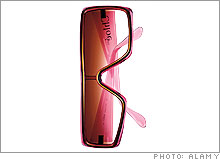Does bling beat the market?With global millionaires doubling since 1996, a crop of investing vehicles focuses on conspicuous-consumption. Can you cash in on the global wealth boom?(Fortune Magazine) -- Remember when it was all the rage to screen socially and environmentally irresponsible stocks, like sweatshop employers or polluters, from your portfolio? Now a new class of niche investment products has emerged to weed out what some see as even worse: the hoi polloi. In February, French bank BNP Paribas and the Deutsche Börse launched the world luxury index, a collection of 20 luxury-goods purveyors from Hermès to LVMH . Merrill Lynch soon followed with the Merrill Lynch lifestyle index, which tracks 50 such stocks. 
In June, British money manager Dominion Group launched Chic, a mutual fund that invests in 61 makers of high-end goods. Even wealth bible Robb Report has gotten into the game, teaming up with Claymore Securities to slap its name on an index and an accompanying exchange-traded fund (ETF). It was launched in July, with a celebration that included the ringing of the opening bell on the New York Stock Exchange and a cake decorated in $1 million worth of Harry Winston diamonds. What's driving the trend? An unprecedented surge in global wealth, for one thing. At the end of last year, according to the 2007 World Wealth Report by Merrill Lynch and consultancy Capgemini, there were 9.5 million millionaires worldwide, double the figure from a decade ago. The resulting tidal wave of spending among newly rich consumers has pushed up prices of everything from watches to rooms at five-star hotels. Shares of stocks that serve the leisure class, too, have been soaring over the past five years. Christian Dior is up 247% since 2002; Richemont, keeper of such brands as Cartier and Chloe, has appreciated 337% in the same period. It was only a matter of time before the financial services industry spotted the pitch-perfect marketing opportunity for a niche investment class. Do these indices deliver? While the products are new, hypothetical runs going back to 2002 show that most have surged. BNP Paribas's index has returned 207% since 2002; Merrill Lynch's has returned 142%. That beats the broader S&P 500 stock market index - including latter-day Ralph Kramden favorites like Bed Bath & Beyond (Charts, Fortune 500) and Campbell Soup (Charts, Fortune 500) - which is up 26% in that time. Whether these so-called bling indices hold up over the long run is a trickier question. The investment case for luxury goods and services is indeed compelling. They don't compete on price, so brands can pretty much charge whatever they want. (How else to explain $3,500 for a handbag?) The barriers to entry are also high; snob appeal is difficult to create overnight. "You can make all the nice leather goods you want, but you won't be Louis Vuitton," says Grégoire Toublanc of BNP Paribas. Margins tend to be around 20%, compared with 2% for all consumer goods. But luxury indices aren't always what they seem. For one thing, the definition of "luxury" leaves a lot of room for interpretation - and interlopers. Dominion's Chic fund, for instance, includes mainstream brands like Apple (Charts, Fortune 500) and Nike (Charts, Fortune 500). The Robb Report ETF includes shares of investment banks with private-wealth management divisions. A bigger reason to give pause might be the existence of the trend itself. Some experts say the appearance of prettily packaged ETFs and other products is the best sign a sector is peaking. By the time the indices appear, says James Carrick, equity strategist at British pension fund Legal & General, "you should have been there five years ago." In fact, Carrick thinks it might be time to do the opposite: Buy the stocks of mass consumer goods companies. Sure, in the midst of a luxury boom you might thumb your nose at the thought of buying McDonald's (Charts, Fortune 500) or Avon. But there's nothing gauche in thinking about where next year's profits might come from. |
Sponsors
| ||||||||||||||||||

